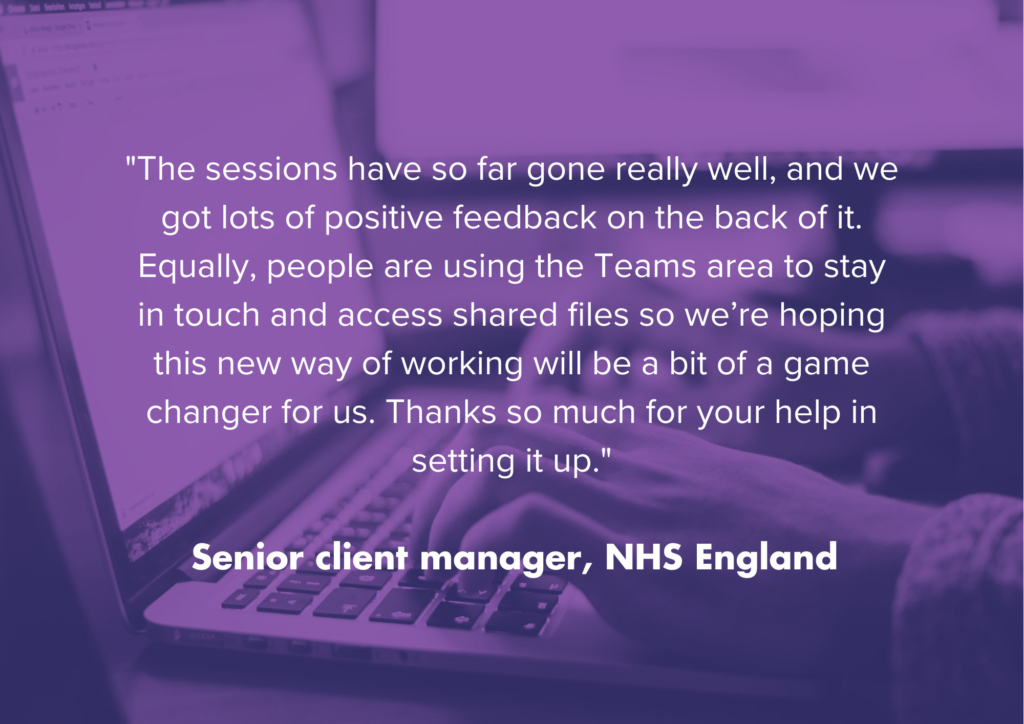2020 has revolutionised the way we work and learn. Our homes became our offices with many of us having to adapt to working completely online and disconnecting from in-person coffees, conferences and commutes. The impacts of the pandemic may have resulted in learning and development budgets being reduced for some, but the silver lining of the remote working ‘new normal’ is that there is a greater opportunity to learn from each other in real-time.
During the summer of 2020, I worked with the team at NHS England to, among other initiatives, develop an online community where social media officers from around the country share and support each other in their work. During one of the most challenging times for our health service, it has never been a more important time to share learnings and skills between one team and another.
Using a group space in Microsoft Teams and members committing to a 30-minute sharing and collaboration session once a month, the community keeps giving back to members at no cost to an L&D budget, aside from the time commitment from individuals. At each session, a different community member prepares a guest presentation about a recent learning or project, which also duals as a networking experience and developmental opportunity for public speaking practice. Outside of sessions, members can ask questions on the forum section of Microsoft Teams to help each other find solutions and offer advice.
Reflecting on the community so far, our senior client manager at NHS England said:

So, how can you create an online community for your team? Here are five pieces of advice to keep in mind when getting started:
1. Create an ‘online first’ community
An online community means that everyone, no matter where they are located, can equally contribute. When the world returns back to office-based working in the future, it’s important to keep the discussions and events primarily online to preserve inclusion and momentum between members who are not co-located. Remember; it’s the varied and diverse experiences of the community which allows everyone a greater shared-learning opportunity.
Ideally, select a hosting platform that community members already have access to and use regularly. As a starting point, consider platforms like Microsoft Teams, Slack or Yammer. The platform should have a space where members can post and comment on threads, upload documents, and have video call functionality for collaboration sessions.
2. Keep events regular and consistent
When starting your community, first survey members to understand the level of commitment members can offer. Weekly collaboration sessions are likely to be too much, so a recommendation would be to plan for fortnightly or monthly sessions, with discussion threads on the community space to keep conversations going in-between. To maintain momentum, book sessions in diaries in advance and try to select the same day and time for sessions to help members remember and regularly commit to attending.
If you find attendance numbers begin to dwindle, evaluate why and look for a solution. Perhaps the time or day of the week is challenging, or the regularity of sessions is too much and needs to be reduced to monthly instead of fortnightly. It can take time to build a community so always aim to try a new solution before cancelling sessions completely.
3. Make sure to have an agenda
The easiest way to plan for sessions and keep them to time is by preparing a simple agenda. To get started, download my Community Agenda template which allows you to sketch out timings, speakers and considerations. If sessions regularly run over time it may discourage members from attending in future, so having a well-planned agenda is vital. Creating an agenda will also allow moderators to let guest speakers know how long they have to complete their presentation, which will help them to prepare.
4. Encourage professional development
Aim to keep the topics and speakers at events varied and encourage members to shape the agenda of collaboration sessions. An inclusive way of doing this is to have a different community member give a guest presentation at each session. Topic ideas could include; evaluation techniques, review of social media channels, campaign insights, or learnings from a recent incident response. Encourage speakers to be from a range of levels to make the most of this developmental opportunity.
Remember public speaking can be a daunting or new experience for some members. For the team at NHS England, I developed a ‘guest speaker information guide’ which advised on presentation timings, recommended number of slides, accessibility and structure. A few tips can help someone who is nervous or less experienced at preparing a presentation feel a lot more in control.
5. Keep it community-led
As a community moderator, take notes of questions asked in collaboration sessions and monitor the regular themes discussed on threads in the online space. What topics are people talking about? What subject attracts interest or questions? Often these themes are a great starting place for future guest presentations.
Creating and maintaining a community takes time and dedication. However, the reward of people learning and gaining professional skills from each other is well worth the investment. After all, during this time of challenge and great change, the need to learn has never been more important.
How could we help you?
Want to create an online learning community within your organisation? Find out how we can help by getting in touch: [email protected]

